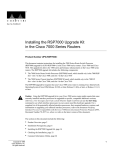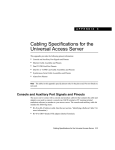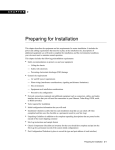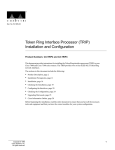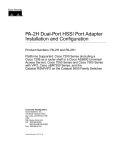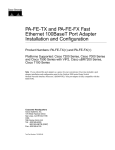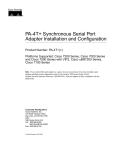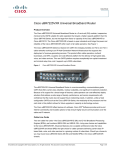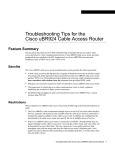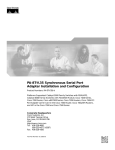Download Cisco E1 cable, DB-15, 120-ohm, Balanced, 5 m
Transcript
C H A P T E R 1 Overview This chapter describes the PA-4E1G port adapter and contains the following sections: • Port Adapter Overview, page 1-1 • Interface Specifications, page 1-2 • LEDs, page 1-4 • Cables, Connectors, and Pinouts, page 1-4 • Port Adapter Slot Locations on the Supported Platforms, page 1-7 • Identifying Interface Addresses, page 1-19 Port Adapter Overview The PA-4E1G, shown in Figure 1-1 and Figure 1-2, provides up to four E1 synchronous serial interfaces, which are compatible with and specified by G.703/G.704. The PA-4E1G network interfaces provide a connection between standard serial interfaces such as V.35 to telephone lines or Post, Telephone, and Telegraph (PTT) networks. Each PA-4E1G interface operates in full-duplex mode at E1 (2.048 Mbps) speed. The PA-4E1G interfaces do not operate in the data terminal equipment (DTE) and data communications equipment (DCE) modes that are typical of data communications interfaces. The PA-4E1G interfaces operate with either a line-recovered or an internal clock signal. The default is for a line clock signal that the interface recovers from the received data stream. The interface can also operate with an internal clock signal. The PA-4E1G generates the internal clock signal; the interface does not use the motherboard or system clock. Figure 1-1 PA-4E1G—75-Ohm, Unbalanced (Front Panel View) E1 G.703/G.704-75 OHM EN LB LA A LB R A LB R 1 LA A LB R LA A R 2 3 H9600 0 LA PA-4E1G Serial Port Adapter Installation and Configuration OL-3065-05 1-1 Chapter 1 Overview Interface Specifications Figure 1-2 PA-4E1G—120-Ohm, Balanced (Front Panel View) E1 G.703/G.704-120 OHM EN LB LA A LB R LA LB LA A LB R 1 LA A R 2 3 H9607 0 A R Features The PA-4E1G provides the following features and capabilities: Note • Provides framed and unframed service access, E1 (2.048 Mbps) line speeds over unbalanced 75-ohm or balanced 120-ohm cable, with 15-pin, D-shell (DB-15) receptacles on the port adapter • Operates over E1 leased-line services, and provides ITU-T G.703 with high-density bipolar of order 3 (HDB3) line encoding • Operates with either an external or internal clock signal, and runs at wire speed • Provides for local and remote loopback testing services • Allows you to fractionalize a data stream into a single channel from 64 kilobits per second (kbps) to 1984 kbps • Provides G.704 framing for n x 64-kbps service support (where n = 1 to 31) • Support for 4-bit cyclic redundancy check (CRC4) to provide and ensure data integrity • Support for point-to-point connections to supported platforms • Eliminates the need for a separate, external data termination unit that is typically used to convert standard serial interfaces, such as V.35, to E1-G.703/G.704 PA-4E1Gs are available as spare parts PA-4E1G-120(=) and PA-4E1G-75(=). Interface Specifications Each PA-4E1G interface is available in either balanced (120-ohm) or unbalanced (75-ohm) mode; a unique port adapter supports each type. Neither the balanced and unbalanced modes nor the balanced and unbalanced cables are interchangeable; you cannot configure a balanced port to support an unbalanced line, nor can you attach an interface cable intended for a balanced line to an unbalanced port. Balanced interfaces typically use three conductors and three signal states: high, low, and ground. The high and low signals mirror each other. Unbalanced interfaces use only two signals: signal and ground. You can discover the mode of each interface by examining the agency approval label on each port adapter, or by using the show controller cbus command. Following is an example of discovering whether the PA-4E1G is in balanced or unbalanced mode: Router# show controllers cbus Serial1/1/0, applique is G.703 Unbalanced [remainder of displayed text omitted from example] Serial1/1/1, applique is G.703 Unbalanced [remainder of displayed text omitted from example] The PA-4E1G interface is divided into 32 time slots or frames. (See Figure 1-3.) PA-4E1G Serial Port Adapter Installation and Configuration 1-2 OL-3065-05 Chapter 1 Overview Interface Specifications Figure 1-3 Time Slot Diagram 2,048 Mbps 32 time slots = 256 bits 8 bits H2402 64 kbps Time slot 0 1 2 3 28 29 30 31 Each of the 32 time slots is an 8-bit frame that transmits data at 64 kbps. Each of these time slots can be configured to carry data or to remain empty. (The PA-4E1G inserts an idle pattern into empty time slots.) Time slot 0, or the first 8 bits, is reserved as overhead. The remaining 248 bits (31 frames with 8 bits each) are designated time slots 1 through 31. Time slot 16 is also designated as a framing slot when using framed mode. When you use framed mode (G.704), you can configure time slot 16 to carry data and operate as any of the other slots; therefore, in framed mode time slot 0 must be designated as a framing signal; time slot 16 can be configured for either data or framing. With framed mode (G.704) you can specify a bandwidth for the interface by designating 31 of the time slots for data and reserving time slot 0 for framing (timing). When you use framed mode, you must designate start and stop time slots; the slots within the start and stop boundaries are used for data, and the remaining slots are left idle. For example, on an interface with framing set on time slots 1 through 8, the interface carries data within the specified 8 frames, and frames 9 through 31 remain idle. Because each time slot transmits at 64 kbps, the interface operates at 512 kbps (8 frames x 64 kbps = 512 kbps). By configuring 16 of the time slots to carry data and the other 16 to remain empty, you can essentially configure the interface for 1.024 Mbps (by leaving half the time slots empty and unable to carry data). The system inserts an idle pattern into unused time slots to identify them as overhead (unused for data). Only one contiguous time slot range can be used. In Private Automatic Branch Exchange (PABX) systems, time slot 16 is always left unused. By default, time slot 16 is not enabled for data in the PA-4E1G interface. The command ts16 overrides the default and enables time slot 16 to carry data. Unframed mode (G.703) uses all 32 time slots for data. None of the 32 time slots are used for framing signals. This allows each of the 32 time slots to transmit at 64 kbps; therefore, 32 time slots x 64 kbps = 2.048 Mbps. While unframed mode is the default, you can also specify unframed mode with the command timeslot 0-0, which specifies time slot 0 as the start slot with no stop (ending) time slot; therefore, all slots are used for data. The no timeslot command restores the default of unframed mode. Framed mode supports a 4-bit cyclic redundancy check (CRC4), which you enable with a software command. The default is for no CRC. Note The E1-G.703/G.704 interface on PA-4E1G is compliant with BABT 221. For more information about CRC4 with a PA-4E1G on a VIP, Cisco 7100 series router, Cisco 7200 series router, or Cisco uBR7200 series router, refer to Chapter 4, “Configuring the PA-4E1G.” PA-4E1G Serial Port Adapter Installation and Configuration OL-3065-05 1-3 Chapter 1 Overview LEDs LEDs The PA-4E1G has one row of three status LEDs for each port and one ENABLED LED. (See Figure 1-4.) The green- and amber-colored LED for each port indicates port status. Figure 1-4 EN PA-4E1G LEDs—Partial Front-Panel View LB LA A R H9602 0 After system initialization, the ENABLED LED goes on to indicate that the port adapter has been enabled for operation. The following conditions must be met before the PA-4E1G is enabled: • The PA-4E1G is correctly connected and receiving power. • A valid system software image for the port adapter has been downloaded successfully. • The system recognizes the PA-4E1G or a VIP with a PA-4E1G. If any of the above conditions are not met, or if the initialization fails for other reasons, the enabled LED does not go on. Table 1-1 lists port LED colors and indications. Table 1-1 PA-4E1G LEDs LED Label Color State Meaning Enabled (EN) Green On Port adapter is enabled for operation. Loopback (LB) Amber On Line or local loopback is active. Local alarm (LA) Amber On A loss of signal (LOS), a loss of frame (LOF), an alarm indication signal (AIS), or any combination of these is detected. Remote alarm (RA) Amber On A remote source indicates an error on its incoming signal. Cables, Connectors, and Pinouts This section describes the port adapter cables for data communications and the PA-4E1G interfaces. Each PA-4E1G provides up to four 15-pin, D-shell (DB-15) receptacles, which support only E1-G.703/G.704 interfaces. The PA-4E1Gs use a DB-15 receptacle for both the balanced and unbalanced ports. The label on the port adapter indicates if the ports on that port adapter are 75-ohm or 120-ohm. (See Figure 1-1 and Figure 1-2.) PA-4E1G Serial Port Adapter Installation and Configuration 1-4 OL-3065-05 Chapter 1 Overview Cables, Connectors, and Pinouts The port adapter end of all E1-G.703/G.704 adapter cables is a DB-15 connector. At the network end, the adapter cable for unbalanced (75-ohm) connections uses a BNC connector. The adapter cables for balanced (120-ohm) connections use DB-15, twinaxial, or RJ-45 connections to accommodate connection standards in different countries. Note Warning You must connect the correct type of interface cable for the port to operate. It is a requirement of the statutory approval of the E1-G.703/G.704 interface that the jackscrews of the connector backshell are securely screwed down while the port adapter is operating. Cables for balanced and unbalanced mode are available with the following types of network-end connectors: • Unbalanced (75-ohm) coaxial cables with BNC connectors at the network end, which are used primarily for connection in the United Kingdom. (See Figure 1-5.) E1-G.703/G.704 Interface Cable for Unbalanced Connections—with BNC Connectors and Coaxial Cables H2421 Figure 1-5 • Balanced (120-ohm) cable with a DB-15 connector at the network end. (See Figure 1-6.) E1-G.703/G.704 Interface Cable for Balanced Connections—with DB-15 Connectors on Both Ends H2476 Figure 1-6 • Balanced (120-ohm) twinaxial split cable (with separate transmit and receive cables), each with a twinaxial connector. (See Figure 1-7.) E1-G.703/G.704 Interface Cable for Balanced Connections—with Twinaxial Connectors and Cables H2424 Figure 1-7 PA-4E1G Serial Port Adapter Installation and Configuration OL-3065-05 1-5 Chapter 1 Overview Cables, Connectors, and Pinouts Cable Product Numbers Table 1-2 lists the product numbers and descriptions of the E1-G.703/G.704 cables. Table 1-2 Product Numbers and Descriptions of E1-G.703/G.704 Port Adapter Cables Cable Product Numbers Description CAB-E1-TWINAX(=)1 E1 cable, twinaxial, 120-ohm, balanced, 5 m CAB-E1-DB15(=) E1 cable, DB-15, 120-ohm, balanced, 5 m CAB-E1-BNC(=) E1 cable, BNC, 75-ohm, unbalanced, 5 m 1. The appended equal sign (=) indicates a spare part. Cable Distance Limitations Unbalanced G.703 interfaces allow for a longer maximum cable length than those specified for balanced circuits. Table 1-3 lists the maximum cable lengths for each E1-G.703/G.704 cable type by the connector used at the network (non-port adapter) end. Table 1-3 E1-G.703/G.704 Maximum Cable Lengths Connection Type BNC Twinaxial Balanced – 300 m Unbalanced 600 m – PA-4E1G Serial Port Adapter Installation and Configuration 1-6 OL-3065-05 Chapter 1 Overview Port Adapter Slot Locations on the Supported Platforms E1-G.703/G.704 Port Adapter Cable Pinouts Table 1-4 shows the signal pinouts for each type of E1-G.703/G.704 interface cable. All cables use a DB-15 connector at the port adapter end. Table 1-4 E1-G.703/G.704 Port Adapter Cable Connector Pinouts Port Adapter End Network End DB-151 DB-152 DB-15 (Null Modem) Twinaxial2 RJ-452 BNC3 Pin Signal4 Pin Pin Signal Pin Signal Signal 9 Tx tip 1 3 Rx tip 4 Rx tip Tip 2 Tx ring 9 11 Rx ring 5 Rx ring Shield 10 Tx shield 2 4 Rx shield 6 Rx shield – 8 Rx tip 3 1 Tx tip 1 Tx tip Tip 15 Rx ring 11 9 Tx ring 2 Tx ring Shield 7 Rx shield 4 2 Tx shield 3 Tx shield – 1. Any pins not described in this table are not connected. 2. 120-ohm, balanced cable 3. 75-ohm, unbalanced cable 4. Tx = transmit, Rx = receive Port Adapter Slot Locations on the Supported Platforms This section discusses port adapter slot locations on the supported platforms. The illustrations that follow summarize slot location conventions on each platform: • Cisco 7000 Series Routers VIP Slot Numbering, page 1-8 • Cisco 7100 Series Routers Slot Numbering, page 1-10 • Cisco 7200 Series Routers and Cisco 7200 VXR Routers Slot Numbering, page 1-11 • Cisco uBR7200 Series Router Slot Numbering, page 1-14 • Cisco 7201 Router Slot Numbering, page 1-16 • Cisco 7301 Router Slot Numbering, page 1-16 • Cisco 7304 PCI Port Adapter Carrier Card Slot Numbering, page 1-17 • Cisco 7401ASR Router Slot Numbering, page 1-18 • Cisco 7500 Series Routers VIP Slot Numbering, page 1-18 PA-4E1G Serial Port Adapter Installation and Configuration OL-3065-05 1-7 Chapter 1 Overview Port Adapter Slot Locations on the Supported Platforms Cisco 7000 Series Routers VIP Slot Numbering Port adapters are supported on the VIPs (versatile interface processors) used in Cisco 7000 series routers. In the Cisco 7000 router, the VIP motherboard is installed vertically in the VIP slot.In the Cisco 7010 router, the VIP motherboard is installed horizontally in the VIP slot. A port adapter can be installed in either bay (port adapter slot 0 or 1) on the VIP. The bays are numbered from left to right on the VIP. Figure 1-8 shows the slot numbering of a VIP. Figure 1-8 VIP Slot Locations Port adapter slot 1 29328 Port adapter slot 0 Port adapter handles not shown PA-4E1G Serial Port Adapter Installation and Configuration 1-8 OL-3065-05 Chapter 1 Overview Port Adapter Slot Locations on the Supported Platforms Cisco 7000 routers have five slots for port adapters, and two slots for Route Switch Processors (RSPs). The slots are numbered from left to right. You can place a port adapter in any of the VIP interface slots (slot 0 through 4). Figure 1-9 shows the slot numbering on a Cisco 7000 router. Figure 1-9 VIP Slots in the Cisco 7000 Router Captive installation screw DC AC FA IL PO WE R Upper power supply I O Captive installation screw DC FA IL PO WE R H2358 AC Lower power supply I O Slot 0 1 2 3 4 SP RP or slot SSP slot PA-4E1G Serial Port Adapter Installation and Configuration OL-3065-05 1-9 Chapter 1 Overview Port Adapter Slot Locations on the Supported Platforms Cisco 7010 routers have three slots for port adapters, and two slots for Route Switch Processors (RSPs). The slots are numbered from bottom to top. You can place a port adapter in any of the VIP interface slots (slot 0 through 2). Slots 3 and 4 are always reserved for RSPs. Figure 1-10 shows the slot numbering on a Cisco 7010 router. Figure 1-10 VIP Slots in the Cisco 7010 Router RP slot SP or SSP slot Interface processor slot 2 Interface processor slot 1 Interface processor slot 0 H2359 Power switch Chassis ground screw Power receptacle DC OK LED AC-input power supply Cisco 7100 Series Routers Slot Numbering Port adapters can be installed in port adapter slot 3 in Cisco 7120 series routers, and in port adapter slot 4 in Cisco 7140 series routers. Figure 1-11 shows the slot numbering on a Cisco 7120 series router. Figure 1-12 shows the slot numbering on a Cisco 7140 series router. Figure 1-11 Port Adapter Slots in the Cisco 7120 Series Router Slot 5 Slot 3 Slot 4 SLOT 0 SLOT 1 PWR ACT ACT 0 FE 0 / 0 I E3 EN TX FE 0/1 LNK LNK 0 1 CONS AUX SYS RDY RX RX 2 CEL CAR ALM 7120 - AE3 Slot 1 Slot 0 18498 5 Slot 2 PA-4E1G Serial Port Adapter Installation and Configuration 1-10 OL-3065-05 Chapter 1 Overview Port Adapter Slot Locations on the Supported Platforms Figure 1-12 Port Adapter Slots in the Cisco 7140 Series Router Slot 5 Slot 3 Slot 4 AC OK DC OK OTF RESET PWR ACT ACT EN 5 0 FE 0 / 0 I SLOT 1 EN RX RX 155 - MM TX CONS 155 - MM RX TX RX EN CEL CAR ALM FE 0 / 1 LNK LNK 0 1 AC OK SYS RDY DC OK OTF 2 CEL CAR ALM 7140 - 2MM3 Slot 0 Slot 1 AUX 18499 SM-ISM SLOT 0 BOOT ERROR Slot 2 Cisco 7200 Series Routers and Cisco 7200 VXR Routers Slot Numbering Cisco 7202 routers have two port adapter slots. The slots are numbered from left to right. You can place a port adapter in either of the slots (slot 1 or slot 2). Figure 1-13 shows the slot numbering on a Cisco 7202 router. Figure 1-13 Port Adapter Slots in the Cisco 7202 Router (blank port adapter installed) Cisco 7200 SERIES 2 CLA TX S LA S 1 SE LA P R RP S E O U RO R P IT DUK RO LA T DU S E DE C T PR R RK OD DE LA UC CLA SS TO E SS 1 LA E SE 1 R CL AS S 1 RX 15 5-S MI T SE RE U PO O WE K R CP 0 EJ EC T SL O T PC M C IA 1O EN AB LE D 0 SL O T 1 FAST ETHERNET INPUT/OUTPUT CONTROLLER 11603 EN 1 AB LE D RX CE RX LLS CA RX RRIE AL R AR M ENHANCED ATM PA-4E1G Serial Port Adapter Installation and Configuration OL-3065-05 1-11 Chapter 1 Overview Port Adapter Slot Locations on the Supported Platforms Cisco 7204 routers and Cisco 7204VXR routers have four slots for port adapters, and one slot for an input/output (I/O) controller. The slots are numbered from the lower left to the upper right, beginning with slot 1 and continuing through slot 4. You can place a port adapter in any of the slots (slot 1 through slot 4). Slot 0 is always reserved for the I/O controller. Figure 1-14 shows the slot numbering on a Cisco 7204 router. The Cisco 7204VXR router is not shown. Figure 1-14 Port Adapter Slots in the Cisco 7204 Router Port adapter slot 4 Port adapter slot 2 Blank port adapter Cisco 7200 SERIES 4 LIN 0 MII K EN AB LE D 0 TX 2 RX 4 TX 3 RX TX RX 2 1 TX RX TX EN LB CD RC RD TC TD LB CD RC RD TC TD LB CD RC RD TC TD LB CD RC EN RD TC ETHERNET-10BFL RX 3 2 3 LINK 1 0 2 1 0 EN AB LE D 3 FAST SERIAL TD RJ 45 FAST ETHERNET ETHERNET 10BT SE RE II 0 D LE AB R E J4 N 5 R LINJ4 K5 M E II N T 0 T EC O EJ SL PC M CIA EN R W P K 1O O H7399 45 CP RJ- U M FE SL O T 1 T 1 FAST ETHERNET INPUT/OUTPUT CONTROLLER Port adapter slot 3 Port adapter slot 1 Port adapter slot 0 PA-4E1G Serial Port Adapter Installation and Configuration 1-12 OL-3065-05 Chapter 1 Overview Port Adapter Slot Locations on the Supported Platforms Cisco 7206 routers and Cisco 7206VXR routers have six slots for port adapters, and one slot for an input/output (I/O) controller. The slots are numbered from the lower left to the upper right, beginning with slot 1 and continuing through slot 6. You can place a port adapter in any of the six slots (slot 1 through slot 6). Slot 0 is always reserved for the I/O controller. Figure 1-15 shows the slot numbering on a Cisco 7206 router. The Cisco 7206VXR router is not shown. Figure 1-15 Port Adapter Slots in the Cisco 7206 Router 3 2 1 0 6 TOKEN RING 5 FAST ETHERNET 4 5 RJ4 MII 0 LIN K D LE AB EN J-4 2 TX RX 4 TX RX 3 TX RX 5 0 T T O M N E SL EC EJ IA C M PC EN AB LE D 0 R II Port adapter slot 5 Port adapter slot 3 Port adapter slot 1 5 J-4 R EN R 5 PW J-4 R INK O K 1 O L 28329 FE M II T O SL 2 RX 1 FAST ETHERNET INPUT/OUTPUT CONTROLLER 1 Cisco 7200 Series TX EN RX 1 0 7 6 5 4 3 2 1 0 ETHERNET-10BFL TX 3 2 3 LINK 1 0 2 1 SERIAL-V.35 EN 3 EN AB LE 0 D ETHERNET 10BT Port adapter slot 6 Port adapter slot 4 Port adapter slot 2 Port adapter slot 0 PA-4E1G Serial Port Adapter Installation and Configuration OL-3065-05 1-13 Chapter 1 Overview Port Adapter Slot Locations on the Supported Platforms Cisco uBR7200 Series Router Slot Numbering The Cisco uBR7223 router has one port adapter slot (slot 1). Slot 0 is always reserved for the I/O controller—if present. Figure 1-16 shows the slot numbering of port adapters on a Cisco uBR7223 router. The Cisco uBR7246 router and Cisco uBR7246VXR router have two port adapter slots (slot1 and slot 2). Slot 0 is always reserved for the I/O controller—if present. Figure 1-17 shows the slot numbering of port adapters on a Cisco uBR7246 router. Figure 1-18 shows the slot numbering of port adapters on a Cisco uBR7246VXR router. Figure 1-16 Port Adapter Slots in the Cisco uBR7233 Router Port adapter slot 0 (I/O controller) uBR - MCI6 5 uBR - MCI6 D S 2 U S U S U S D LE U S AB 1 EN 0 Cable modem card slot 2 Cable modem card slot 3 15745 5 D S 4 U S 3 U S 2 U S 1 U S U S D LE AB 0 EN U S Port adapter slot 1 PA-4E1G Serial Port Adapter Installation and Configuration 1-14 OL-3065-05 Chapter 1 Overview Port Adapter Slot Locations on the Supported Platforms Port Adapter Slots in the Cisco uBR7246 Router 5 uBR - MCI6 5 uBR - MCI6 5 uBR - MCI6 5 uBR - MCI6 S S Port adapter slot 2 D U S 4 U S 3 U 2 U S 1 U D 0 U LE Port adapter slot 1 (blank) S S D U S 2 U S D 1 U U LE 0 S S D U S 2 U S D 1 U U LE 0 D H11323 S S U S 2 U S D 1 U U LE 0 EN AB S EN AB S EN AB S EN AB S Port adapter slot 0 (I/O controller) S Figure 1-17 Cable modem card slot 3 Cable modem card slot 4 Cable modem card slot 5 Cable modem card slot 6 Figure 1-18 Port Adapter Slots in the Cisco uBR7246VXR Router Port adapter slot 0 (I/O controller) Port adapter slot 1 (blank) Port adapter slot 2 uBR - CLK-T1 SEC LOS ACTIVE 5 uBR - MCI6 5 uBR - MCI6 5 uBR - MCI6 5 uBR - MCI6 S S D 4 U S 3 U S U S 2 U S D 1 U U LE 0 FAULT S S D U S 2 U S D 1 U U LE 0 S S D U S 2 U S D 1 U U LE 0 31501 S D S 2 U S 1 U S U D LE U 0 EN AB S EN AB S EN AB S EN AB S FREERUN ER Line card slot 3 Line card slot 4 Line card slot 5 Line card slot 6 PA-4E1G Serial Port Adapter Installation and Configuration OL-3065-05 1-15 Chapter 1 Overview Port Adapter Slot Locations on the Supported Platforms Cisco 7201 Router Slot Numbering Figure 1-19 shows the front view of a Cisco 7201 router with a port adapter installed. There is only one port adapter slot (slot 1) in a Cisco 7201 router. Figure 1-19 Port Adapter Slot in the Cisco 7201 Router Port adapter slot D R LE LS RIE M AB EL AR AR EN RX C RX C X AL R ATM Cisco 720 1 PA SLOT 1 LINK/ACTV SFP CONSOLE RJ45 EN LINK/ACTV TX SFP RX LINK/ACTV SFP LINK/ACTV TX SFP RX GE 0/0 230308 RJ45 EN MNGMNT USE ONLY GE 0/1 GE 0/2 ALARM GE 0/3 AUX FE 0/0 FE LINK PWR OK 0 COMPACT FLASH STATUS CF ACTV Cisco 7301 Router Slot Numbering Figure 1-20 shows the front view of a Cisco 7301 router with a port adapter installed. There is only one port adapter slot (slot 1) in a Cisco 7301 router. Figure 1-20 Cisco 7301 Router with a Port Adapter Installed Port adapter slot D LE AB EN S IER LL R RM CE CAR LA RX RX RX A ATM GIGABIT ETHER NET RJ45 EN 0/0 LINK TX GBIC GIGABIT ETHER NET RX RJ45 EN 0/1 LINK TX GBIC GIGABIT ETHER NET RX RJ45 EN 0/2 LINK TX GBIC AUX RX CISCO 7400 CISCO 7411SERIES CONSOLE ALARM COMPACT FLASH STATUS 100-24 0V, 2A, 50/60 Hz 24V=9 A, 48 - 60V=5 A 84988 SLOT 1 PA-4E1G Serial Port Adapter Installation and Configuration 1-16 OL-3065-05 Chapter 1 Overview Port Adapter Slot Locations on the Supported Platforms Cisco 7304 PCI Port Adapter Carrier Card Slot Numbering The Cisco 7304 PCI Port Adapter Carrier Card installs in Cisco 7304 router module slots 2 through 5. Figure 1-21 shows a Cisco 7304 PCI Port Adapter Carrier Card with a port adapter installed. The Cisco 7304 PCI Port Adapter Carrier Card accepts one single-width port adapter. Figure 1-22 shows the module slot numbering on a Cisco 7304 router. The port adapter slot number is the same as the module slot number. Slot 0 and slot 1 are reserved for the NPE module or NSE module. Figure 1-21 7300-C Cisco 7304 PCI Port Adapter Carrier Card—Port Adapter Installed C-PA 84653 D R LE LS RIE M AB CEL AR AR EN RX RX C X AL R OIR STATUS 7300 PA ATM CARRIER Figure 1-22 Module Slots on the Cisco 7304 Router Slot 4 7300-2 OC3AT M-MM TX OIR 0 Slot 5 RX STATUS TX 2-PORT OC3 ATM CARRIER ALARM/ 9K-10C 1 RX MM 48 ACTIVE/ LOOPBA CK CARRIER ALARM/ ACTIVE/ LOOPBA CK TX OIR RX STATUS 1-POR T OC48 POS w/ 9K-40C3 /POS-M M SMSR OIR STATUS 4-POR T OC3 POS 0 1 2 3 w/ MM CARRIE R/ ALARM 70550 ACTIVE/ LOOPBA CK Slot 0 Slot 2 Slot 3 Slot 1 PA-4E1G Serial Port Adapter Installation and Configuration OL-3065-05 1-17 Chapter 1 Overview Port Adapter Slot Locations on the Supported Platforms Cisco 7401ASR Router Slot Numbering Figure 1-23 shows the front view of a Cisco 7401ASR router with a port adapter installed. There is only one port adapter slot (slot 1) in a Cisco 7401ASR router. Figure 1-23 D R LE LS RIE M AB EL AR AR EN RX C RX C X AL TX RX ENHANCED ATM 57680 R Port Adapter Slot in the Cisco 7401ASR Router Cisco 7500 Series Routers VIP Slot Numbering Port adapters are supported on the VIPs (versatile interface processors) used in Cisco 7500 series routers. In the Cisco 7505 router, the VIP motherboard is installed horizontally in the VIP slot. In the Cisco 7507 router and Cisco 7513 router, the VIP motherboard is installed vertically in the VIP slot. A port adapter can be installed in either bay (port adapter slot 0 or 1) on the VIP. The bays are numbered from left to right on the VIP. Figure 1-24 shows the slot numbering on a VIP. Figure 1-24 VIP Slot Locations Port adapter slot 1 29328 Port adapter slot 0 Port adapter handles not shown PA-4E1G Serial Port Adapter Installation and Configuration 1-18 OL-3065-05 Chapter 1 Overview Identifying Interface Addresses Cisco 7505 routers have four slots for port adapters, and one slot for an RSP. The slots are numbered from bottom to top. You can place a port adapter in any of the VIP interface slots (slot 0 through 3). One slot is always reserved for the RSP. Figure 1-25 shows the slot numbering on a Cisco 7505 router. Figure 1-25 VIP Slots in the Cisco 7505 Router VIP in interface processor slot 3 T SE E OL NS CO U RE CP EC EJ AL RM NO SL S L O OT T 0 1 T HA LT ROUTE SWITCH PROCESSOR Slot 3 Slot 2 Interface processor Slot 1 slots 29619 Slot 0 Cisco 7507 routers have five slots for port adapters, and two slots for RSPs. The slots are numbered from left to right. You can place a port adapter in any of the VIP interface slots (slot 0, 1, 4, 5, or 6). Slots 2 and 3 are always reserved for RSPs. The Cisco 7507 router is not shown. Cisco 7513 routers have eleven slots for port adapters, and two slots for RSPs. The slots are numbered from left to right. You can place a port adapter in any of the VIP interface slots (slots 0 through 5, or slots 9 through 12). Slots 6 and 7 are always reserved for RSPs. The Cisco 7513 router is not shown. Identifying Interface Addresses This section describes how to identify interface addresses for the PA-4E1G in supported platforms. Interface addresses specify the actual physical location of each interface on a router or switch. Interfaces on a PA-4E1G installed in a router maintain the same address regardless of whether other port adapters are installed or removed. However, when you move a port adapter to a different slot, the first number in the interface address changes to reflect the new port adapter slot number. Interfaces on a PA-4E1G installed in a VIP maintain the same address regardless of whether other interface processors are installed or removed. However, when you move a VIP to a different slot, the interface processor slot number changes to reflect the new interface processor slot. PA-4E1G Serial Port Adapter Installation and Configuration OL-3065-05 1-19 Chapter 1 Overview Identifying Interface Addresses The following subsections describe the interface address formats for the supported platforms: • Cisco 7000 Series Routers VIP Interface Addresses, page 1-21 • Cisco 7100 Series Routers Interface Addresses, page 1-22 • Cisco 7200 Series Routers and Cisco 7200 VXR Routers Interface Addresses, page 1-22 • Cisco uBR7200 Series Routers Interface Addresses, page 1-22 • Cisco 7201 Router Interface Addresses, page 1-22 • Cisco 7301 Router Interface Addresses, page 1-23 • Cisco 7304 PCI Port Adapter Carrier Card Interface Addresses, page 1-23 • Cisco 7401ASR Router Interface Addresses, page 1-23 • Cisco 7500 Series Routers VIP Interface Addresses, page 1-23 Table 1-5 summarizes the interface address formats for the supported platforms. Table 1-5 Identifying Interface Addresses Platform Interface Address Format Numbers Syntax VIP in Cisco 7000 series routers Interface-processor-slot-number/port-adapter-slotnumber/interface-port-number Interface processor slot—0 through 4 (depends on the number of slots in the router) 3/1/0 Port adapter slot— 0 or 1 Interface port—0 through 3 Cisco 7120 series router Port-adapter-slot-number/interface-port-number Port adapter slot—always 3 3/1 Interface port—0 through 3 Cisco 7140 series router Port-adapter-slot-number/interface-port-number Port adapter slot—always 4 4/0 Interface port—0 through 3 Cisco 7200 series routers and Cisco 7200 VXR routers (Cisco 7202, Cisco 7204, Cisco 7204VXR, Cisco 7206, Cisco 7206VXR) Port-adapter-slot-number/interface-port-number Cisco 7201 router Port-adapter-slot-number/interface-port-number Port adapter slot—1 through 1/0 6 (depends on the number of slots in the router)1 Interface port—0 through 3 Port adapter slot—always 1 1/0 Interface port—0 through 3 Cisco uBR7223 router Port-adapter-slot-number/interface-port-number Port adapter slot—always 11 1/0 Interface port—0 through 3 Cisco uBR7246 and Cisco uBR7246 VXR routers Port-adapter-slot-number/interface-port-number Cisco 7301 routers Port-adapter-slot-number/interface-port-number Port adapter slot—1 or 21 1/0 Interface port—0 through 3 Port adapter slot—always 1 1/0 Interface port—0 through 3 PA-4E1G Serial Port Adapter Installation and Configuration 1-20 OL-3065-05 Chapter 1 Overview Identifying Interface Addresses Table 1-5 Identifying Interface Addresses (continued) Platform Interface Address Format Numbers Syntax Cisco 7304 PCI Port Adapter Carrier Card in Cisco 7304 routers Module-slot-number/interface-port-number Module slot—2 through 5 3/0 Cisco 7401ASR routers Port-adapter-slot-number/interface-port-number Interface port—0 through 3 Port adapter slot—always 1 1/0 Interface port—0 through 3 VIP in Cisco 7000 series or Cisco 7500 series routers Interface-processor-slot-number/port-adapter-slotnumber/interface-port-number Interface processor slot—0 through 12 (depends on the number of slots in the router) 3/1/0 Port adapter slot—0 or 1 Interface port—0 through 3 1. Port adapter slot 0 is reserved for the Fast Ethernet port on the I/O controller (if present). Cisco 7000 Series Routers VIP Interface Addresses In Cisco 7000 series routers, port adapters are installed on a versatile interface processor (VIP), which installs in interface processor slots 0 through 4 (depending on the number of slots in the router). The port adapter can be installed in either bay (port adapter slot 0 or 1) on the VIP. See Figure 1-8, Figure 1-9, and Figure 1-10 The interface address for the VIP is composed of a three-part number in the format interface-processor-slot-number/port-adapter-slot-number/interface-port-number. See Table 1-5. The first number identifies the slot in which the VIP is installed (slot 0 through 4, depending on the number of slots in the router). The second number identifies which bay on the VIP the port adapter is installed (0 or 1). The bays are numbered from left to right on the VIP. The third number identifies the physical port number (interface port number) on the port adapter. The port numbers always begin at 0 and are numbered from left to right. The number of additional ports depends on the number of ports on the port adapter. The PA-4E1G is a four-port port adapter, therefore the port can be 0 through 3. For example, if the four-port PA-4E1G is installed in a VIP in interface processor slot 3, port adapter slot 1, the interface addresses would be 3/1/0, 3/1/1. 3/1/2, and 3/1/3 (interface processor slot 3, port adapter slot 1, and interfaces 0,1, 2, and 3). Note Although the processor slots in the 7-slot Cisco 7000 are vertically oriented and those in the 5-slot Cisco 7010 are horizontally oriented, all Cisco 7000 series routers use the same method for processor slot and interface port numbering. PA-4E1G Serial Port Adapter Installation and Configuration OL-3065-05 1-21 Chapter 1 Overview Identifying Interface Addresses Cisco 7100 Series Routers Interface Addresses In Cisco 7120 series router, port adapters are installed in port adapter slot 3. See Figure 1-11. In the Cisco 7140 series router, port adapters are installed in port adapter slot 4. See Figure 1-12. The interface address is composed of a two-part number in the format port-adapter-slot-number/interface-port-number. See Table 1-5. For example, if a four-port PA-4E1G is installed on a Cisco 7120 router, the interface addresses would be 3/0 through 3/3. If a four-port PA-4E1G is installed on a Cisco 7140 router, the interface addresses would be 4/0 through 4/3. Cisco 7200 Series Routers and Cisco 7200 VXR Routers Interface Addresses In Cisco 7200 series routers and Cisco 7200 VXR routers, port adapter slots are numbered from the lower left to the upper right, beginning with slot 1 and continuing through slot 2 for the Cisco 7202, slot 4 for the Cisco 7204 and Cisco 7204VXR, and slot 6 for the Cisco 7206 and Cisco 7206VXR. Port adapters can be installed in any available port adapter slot from 1 through 6 (depending on the number of slots in the router). (Slot 0 is reserved for the I/O controller.) See Figure 1-13, Figure 1-14, and Figure 1-15 The interface address is composed of a two-part number in the format port-adapter-slot-number/interface-port-number. See Table 1-5. For example, if a four-port PA-4E1G is installed in slot 1of a Cisco 7200 series router, the interface addresses would be 1/0 through 1/3. Cisco uBR7200 Series Routers Interface Addresses In the Cisco uBR7223 router, only one slot accepts port adapters and it is numbered slot 1. See Figure 1-16 In the Cisco uBR7246 router and Cisco uBR7246VXR router, port adapters can be installed in two port adapter slots (slot1 and slot 2). Slot 0 is always reserved for the I/O controller—if present. See Figure 1-17 and Figure 1-18. The interface address is composed of a two-part number in the format port-adapter-slot-number/interface-port-number. See Table 1-5. For example, if a four-port PA-4E1G is installed in slot 1of a Cisco uBR7223 series router, the interface addresses would be 1/0 through 1/3. If a four-port PA-4E1G is installed in slot 2 of a Cisco uBR7246 or Cisco uBR7246VXR router, the interface addresses would be 2/0 through 2/3. Cisco 7201 Router Interface Addresses In the Cisco 7201 router, only one slot accepts port adapters and it is numbered as slot 1. See Figure 1-19. The interface address is composed of a two-part number in the format port-adapter-slot-number/interface-port-number. See Table 1-5. For example, if a four-port PA-4E1G is installed in a Cisco 7201 router, the interface addresses would be 1/0 through 1/3. PA-4E1G Serial Port Adapter Installation and Configuration 1-22 OL-3065-05 Chapter 1 Overview Identifying Interface Addresses Cisco 7301 Router Interface Addresses In the Cisco 7301 router, only one slot accepts port adapters and it is numbered as slot 1. See Figure 1-20. The interface address is composed of a two-part number in the format port-adapter-slot-number/interface-port-number. See Table 1-5. For example, if a four-port PA-4E1G is installed in a Cisco 7301 router, the interface addresses would be 1/0 through 1/3. Cisco 7304 PCI Port Adapter Carrier Card Interface Addresses In the Cisco 7304 router, port adapters are installed in a Cisco 7304 PCI port adapter carrier card, which installs in Cisco 7304 router module slots 2 through 5. The port adapter slot number is the same as the module slot number. See Figure 1-21 and Figure 1-22. The interface address is composed of a two-part number in the format module-slot-number/interface-port-number. See Table 1-5. For example, if a four-port PA-4E1G is installed in the Cisco 7304 PCI port adapter carrier card in Cisco 7304 router module slot 3, the interface addresses would be 3/0 through 3/3. Cisco 7401ASR Router Interface Addresses In the Cisco 7401ASR router, only one slot accepts port adapters and it is numbered as slot 1. See Figure 1-23. The interface address is composed of a two-part number in the format port-adapter-slot-number/interface-port-number. See Table 1-5. For example, if a four-port PA-4E1G is installed in a Cisco 7401ASR router, the interface addresses would be 1/0 through 1/3. Cisco 7500 Series Routers VIP Interface Addresses In Cisco 7000 series routers and Cisco 7500 series routers, port adapters are installed on a versatile interface processor (VIP), which installs in interface processor slots 0 through 12 (depending on the number of slots in the router). The port adapter can be installed in either bay (port adapter slot 0 or 1) on the VIP. See Figure 1-24, and Figure 1-25. The interface address for the VIP is composed of a three-part number in the format interface-processor-slot-number/port-adapter-slot-number/interface-port-number. See Table 1-5. The first number identifies the slot in which the VIP is installed (slot 0 through 12, depending on the number of slots in the router). The second number identifies the bay (port adapter slot) on the VIP in which the port adapter is installed (0 or 1). The bays are numbered from left to right on the VIP. The third number identifies the physical port number (interface port number) on the port adapter. The port numbers always begin at 0 and are numbered from left to right. The number of additional ports depends on the number of ports on the port adapter. The PA-4E1G is a four-port port adapter, therefore the port can be 0 through 3. PA-4E1G Serial Port Adapter Installation and Configuration OL-3065-05 1-23 Chapter 1 Overview Identifying Interface Addresses For example, if a four-port PA-4E1G is installed in a VIP in interface processor slot 3, port adapter slot 1, the interface addresses would be 3/1/0 through 3/1/3 (interface processor slot 3, port adapter slot 1, and interfaces 0, 1, 2 and3). Note Although the processor slots in the 7-slot Cisco 7507 and the 13-slot Cisco 7513 and Cisco 7576 are vertically oriented and those in the 5-slot Cisco 7505 are horizontally oriented, all Cisco 7500 series routers use the same method for slot and interface port numbering. PA-4E1G Serial Port Adapter Installation and Configuration 1-24 OL-3065-05

























